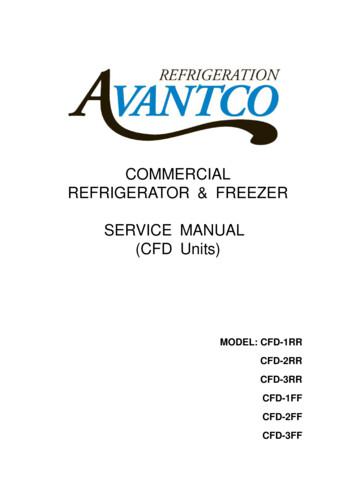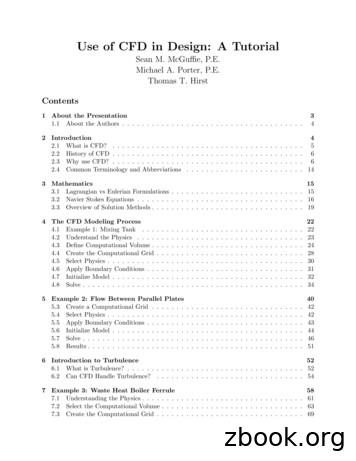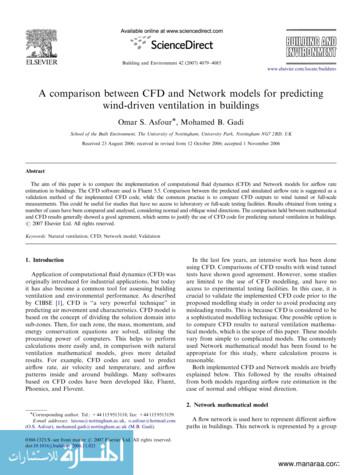Cfd Analysis Of Room With Air Conditioner By Using Ansys Workbench
2018 JETIR July 2018, Volume 5, Issue 7www.jetir.org (ISSN-2349-5162)CFD ANALYSIS OF ROOM WITH AIRCONDITIONER BY USING ANSYSWORKBENCHAbhinandan Kumar1, V. N. Bartaria2Mechanical Engineering Department, LNCT Bhopal2Mechanical Engineering Department, LNCT Bhopal1Abstract: - The experimental analysis has been performed within two equal varieties of room for air conditioning and studieddistinct duct locations in the room and optimize minimum room cooling time. The consequences of the air-conditioning device’soverall performance and thermal consolation evaluation are presented and an evaluation is made to the exceptional locations ofdelivering air flow. In this research, numerous locations utilized for Air Conditioning air go with the flow supply. two roomsdesigned with the same dimensions at different locations of the Air conditioner unit in the room. Room designing and evaluationachieved in ANSYS CFD tool. Thermal situations of room optimized with ANSYS CFD Simulation tool.Keywords: Air-conditioning control, thermal comfort, FEM, CFD Analysis.I. IntroductionAir conditioning is the manner of conditioning the indoor air for the specified thermal comfort. An air conditioner is anequipment, gadget or system, designed to stabilize the air temperature and humidity inside an area. It is utilized for cooling aswell as heating, relying at the air temperature at a given time, generally using refrigeration cycle. Sometimes, evaporative coolingis utilized for consolation cooling in building and motor vehicles. Air conditioning in particular is utilized for consolation andmanner software. Comfort software objectives to offer a constructing indoor surroundings meaning particularly steady in a range,preferred through human beings, no matter the adjustments in outside climate conditions or in inner heat hundreds. Comfortprograms for diverse building sorts are quite exceptional and may be labeled as low- upward thrust building, high- rise building,business building, institutional constructing and business space. Process programs purpose to provide a suitable surroundings fora manner being performed, irrespective of internal warmness and humidity hundreds and outside climate conditions. Processpackages consist of Data Centers, Textile Industries, Chemical and Biological Laboratories, Mines and others. Air-conditioning inwarm and arid environments, is an essential requirement for supporting of each day human activities.II.Computational Fluid DynamicsCFD is a place wherein the governing equations for fluid flows are solved in discrete shape on computers by way of simulatingthe fluid glide trouble. This enables in reducing the time and effort required in narrowing down on the design configurations ofdiverse engineering additives. In the present work a 3 dimensional numerical simulation became carried out to have a look at theresults of different Ac rooms by way of using various places of AC duct. The simulation of float in inner combustion engines is acomplicated procedure concerning fluid dynamics and turbulent motion. Any physical fluid flow trouble can be solved eitherexperimentally or numerically. The numerical simulation is greater appropriate for parametric studies and it also offers accurateconsequences through solving governing equations in every and each cellular of the fluid area. In the current years there havebeen incredible improvement in the subject of numerical strategies, which made a remarkable effect on the evaluation of complexfloat issues and reaching their solution. Computational Fluid Dynamics (CFD) has grown from a mathematical curiosity to acritical tool in nearly every branch of fluid dynamics. CFD is considered as a bridge between the natural experimental fluiddynamics and pure theoretical fluid dynamics. Until currently, researchers needed to mainly rely upon time consuming and priceyexperimentations for analyzing complicated float troubles. With the advent of effective virtual computers and numericalsimulation strategies, the quantity of experimentation required for reading complicated engineering problems has been reducedconsiderably.III.Modelling of Room design in AnsysThe ANSYS CFX (fluid flow) software is fully integrated into the ANSYS Workbench environment, the framework for the entiresuite of engineering simulation solutions. Its adaptive architecture enables users to easily set up anything from standard fluid flowanalyses of complex interacting systems with simple drag-and-drop operations. The geometry that has been created in a CAD(computer-aided design) system or builds the geometry from scratch. The ANSYS Design Modeler is a gateway to geometryhandling for an ANSYS analysis. Geometry created using ANSYS Design Modeler software which is specifically designed forthe creation and preparation of geometry for simulation. In engineering simulations, the geometry includes details not needed forsimulation. Only the physics involved is to be included, simulating such a fully detailed model will increase solver run times.JETIR1807263Journal of Emerging Technologies and Innovative Research (JETIR) www.jetir.org99
2018 JETIR July 2018, Volume 5, Issue 7www.jetir.org (ISSN-2349-5162)In engineering simulations, the geometry includes details not needed for simulation. Only the physics involved is to be included,simulating such a fully detailed model will increase solver run times. It can be more efficient to spend a short time removing thesedetails to reduce the total run time by hours or days. Fig 1 and 2 shows the geometry created of A. C. Room with duct locationand various features of Design modeler and outline tree with Air conditioning room with dimension of room are explained intable.Parameters Table 1: Dimension ParametersRoom dimensions (meter)Dimension of Duct (meter)Length50.5Width3.651.2Height30.4Case Study 1 of AC RoomIn this case Room designed with 5 m x 3.65 m x 3 m and duct is divided here in two part; each duct is utilized with 0.19 m/sair flow velocity. first duct is placed 3 feet from base and second duct placed 6 feet above from the first duct. Roomtemperature is 313K and temperature of Air at inlet point of AC duct is 291K, over all Air velocity of both duct is 0.39 m/s.Figure shows the arrangement of AC room with double duct.Figure 1: Geometry of Room 2 with A. C. Dust Case Study 2 of AC RoomIn this case Room designed with 5 m x 3.65 m x 3 m and duct is divided here in two part; each duct is utilized with 0.19 m/sair flow velocity. Both AC Dust place in front of each other in room wall.first duct is placed 9 feet from base on left wall of the room and second duct placed 9 feet above from the base on the rightside wall. Room temperature is 313K and temperature of Air at inlet point of AC duct is 291K, over all Air velocity of bothduct is 0.39 m/s. Figure 2 shows the arrangement of AC room with double duct.JETIR1807263Journal of Emerging Technologies and Innovative Research (JETIR) www.jetir.org100
2018 JETIR July 2018, Volume 5, Issue 7www.jetir.org (ISSN-2349-5162)Figure 2: Geometry of Room 2 with A. C. DustIV. Results and DiscussionCase 1 of AC roomFigure 3: Room 1 Designed in ANSYSFigure 4: Temperature variations in Room 1Figure 5: Pressure Generated due to Air flow in Room 1 Figure 6: Streamline of Air flow in Room 1Case 2 of AC RoomFigure 7: Room 2 Designed in ANSYSJETIR1807263Figure 8: Temperature variations in Room 2Journal of Emerging Technologies and Innovative Research (JETIR) www.jetir.org101
2018 JETIR July 2018, Volume 5, Issue 7Figure 9: Pressure Generated due to Air in Room 2www.jetir.org (ISSN-2349-5162)Figure 10: Streamline of Air flow in Room 2Above graph and figures shows the variations of AC Rooms temperatures, Pressure of Air in Room and effects of room duringAir circulation by AC duct. Table 1 shows the Temperature difference comparison of All two cases of room study with differentDuct positions. Table 2 shows pressure difference and table 3 shows time of cooling in seconds in Room 1 and Room 2.Table 2: Comparison of Results with all three cases of AC RoomRoomsMinimum Temperature of RoomRoom 121.8Room 221.9Table 3: Pressure difference in Room 1 and Room 2RoomsPressureRoom 10.092Room 21.198Table 4: Cooling Time in Room 1 and Room 2RoomsTime of Cooling secondsRoom 1109Room 291In Room 1 conditions double duct utilized for air flow but mass flow rate of air kept constant so after study in room 1 maximumtime 109 second for temperature 21.8 0C found. In Room 2 double duct utilized in front of each other and maximum temperaturefound 21.9 and maximum time taken during temperature drop is 91 second. So case 2 Room with double AC duct but same massflow rate is better arrangement for early cooling system because it takes less time of cooling 721.6521.6Double AC Duct Room 2Double AC Duct Infront of eachother Room 3RoomsFigure 11: Temperature difference in Room 1 Vs Room 2JETIR1807263Journal of Emerging Technologies and Innovative Research (JETIR) www.jetir.org102
2018 JETIR July 2018, Volume 5, Issue 7www.jetir.org 0920Double AC Duct Room 2Double AC Duct Infront of eachother Room 3RoomsFigure 12: Pressure difference in Room 1 Vs Room 2SecondsTime of Cooling in seconds1151101051009590858010991Room 2Room 3RoomsFigure 13: Colling time of Room 1 Vs Room 2V. ConclusionIn the present work, an extensive data analysis has been made to study the cooling potential for AC Duct location, using the threedifferent location of duct in Same dimension rooms, optimize suitable method of cooling by comparing the results of This study.Following conclusions are made as per above study. While there are several experimental investigations performed by researchers regarding the Air conditioning of Rooms.On the basis of 3-D finite element modeling of conventional room design. The obtained data showed how roomtemperature drops with respect to time during CFD analysis using FLUENT was considered. The modeling, meshing,preprocessing and analysis portion of the work is performed in ANSYS V14.0. And the results obtained under boundary conditions taken into consideration are discussed. The results obtained duringanalysis are shown above, it can be concluded that the Room 2 conditions has shown better results because it take lesstime to make comfort temperature from 40 0C to 21.9 0C. it is concluded that in Room 1 conditions double duct used for air flow but mass flow rate of air kept constant so afterstudy in room 2 maximum time 109 second for temperature 21.8 0C found. In Room 2 double duct used in front of eachother and maximum temperature found 21.9 and maximum time taken during temperature drop is 91 second. So case 2Room with double AC duct but same mass flow rate is better arrangement for early cooling system because it takes lesstime of cooling room.References1.2.Zhou, Zhong, Liu, "Study on the Relationship between Thermal Comfort and Air-Conditioning Energy Consumption inDifferent Cities", Journal of Computers, Vol. 28, No. 2, 2017, pp. 135-143.Jing Ni, Bowen Jin, Bo Zhang, "Simulation of Thermal Distribution and Airflow for Efficient Energy Consumption in aSmall Data Centers", Sustainability, 2017.JETIR1807263Journal of Emerging Technologies and Innovative Research (JETIR) www.jetir.org103
2018 JETIR July 2018, Volume 5, Issue 73.4.5.6.7.8.9.10.11.12.13.14.15.www.jetir.org (ISSN-2349-5162)Kanga, Peng, Chenga, "Analysis of Condensation and Thermal Comfort of Two Kinds of Compound Radiant CoolingAir Conditioning Systems Based on Displacement Ventilation", 10th International Symposium on Heating, Ventilationand Air Conditioning, ISHVAC2017, October 2017.Bamodu, Xia, Tang, "A numerical simulation of air distribution in an office room ventilated by 4-way cassette airconditioner", ICAE, Elsevier, 2016.Ding, Guo, Chen, "Design and simulation of an air conditioning project in a hospital based on computational fluiddynamics", Archives of civil engineering, Volume 13, Issue 2, 2017.DU, Lei, Chena, "The indoor thermal environment simulation and testing validation of a power plant turbine room inextreme cold area", 8th International Cold Climate HVAC Conference, Elsevier, 2016.Popovicia, Hudisteanua,"Numerical simulation of HVAC system functionality in a sociocultural building", InternationalConference Interdisciplinary in Engineering, Elsevier, 2016.Aryal, Leephakpreeda, "CFD analysis on thermal comfort and indoor air quality affected by partitions in air-conditionedbuilding", Applied Mechanics and Materials, Vol. 836, pp 121-126, 2016.Satyam, Jagtap, Archana, "Design and Development of Portable Air Conditioner", International Journal for Research inEngineering Application & Management, Volume 02, Issue 7, 2016.Sudhangshu Sarma, O. P. Jakhar,"Computational Analysis of Impact of the Air-Conditioner Location On Temperatureand Velocity Distribution in an Office-Room", International Research Journal of Engineering and Technology (IRJET),Volume: 03, Issue: 09, Sep -2016.Pillai, Bhand, Shinde, "A Review on CFD Analysis in Air-Conditioning System", International Journal of CurrentEngineering and Technology, 2016.D prakash, "Transient analysis and improvement of indoor thermal comfort for an air-conditioned room with thermalinsulations", Ain Shams Engineering Journal, Elsevier, 2015.Thakur,Patel, Parth, "Quantification of Air Flow Pattern in Air Conditioned Room – A Review", International Journal ofAdvance Engineering and Research Development Volume 1,Issue 12, December -2014.Calautit, Hughes, "Wind tunnel and CFD study of the natural ventilation performance of a commercial multi-directionalwind tower", Building and Environment, Volume 80, October 2014, PP 71-83.Mallikarjun, Malipatil, "CFD Analysis of Air Cooled Condenser by Using Copper Tubes and Aluminum Fins",International Journal for Research in Applied Science & Engineering Technology, Volume 2 Issue X, October 2014.JETIR1807263Journal of Emerging Technologies and Innovative Research (JETIR) www.jetir.org104
Keywords: Air-conditioning control, thermal comfort, FEM, CFD Analysis. I. Introduction Air conditioning is the manner of conditioning the indoor air for the specified thermal comfort. An air conditioner is an equipment, gadget or system, designed to stabilize the air temperature and humidity inside an area. It is utilized for cooling as
refrigerator & freezer . service manual (cfd units) model: cfd-1rr . cfd-2rr . cfd-3rr . cfd-1ff . cfd-2ff . cfd-3ff . 1 table of contents
430 allocation to elianto cfd o&m 20,577.32 440 allocation to trillium west cfd o&m 27,267.00 450 allocation to west park cfd o&m 70,008.22 460 allocation to festival ranch cfd o&m 177,790.54 480 allocation to tartesso west cfd o&m 27,809.17 481 allocation to anthem sun valley cfd o&
A.2 Initial Interactive CFD Analysis Figure 2: Initial CFD. Our forward trained network provides a spatial CFD analysis prediction within a few seconds and is visualised in our CAD software. A.3 Thresholded and Modified CFD Analysis Figure 3: Threshold. The CFD is thresholded to localise on
CFD Analysis Process 1. Formulate the Flow Problem 2. Model the Geometry 3. Model the Flow (Computational) Domain 4. Generate the Grid 5. Specify the Boundary Conditions 6. Specify the Initial Conditions 7. Set up the CFD Simulation 8. Conduct the CFD Simulation 9. Examine and Process the CFD Results 10. F
performing CFD for the past 16 years and is familiar with most commercial CFD packages. Sean is the lead author for the tutorial and is responsible for the following sections: General Procedures for CFD Analyses Modeling Turbulence Example 3 - CFD Analysis
The CFD software used i s Fluent 5.5. Comparison between the predicted and simulated airflow rate is suggested as a validation method of the implemented CFD code, while the common practice is to compare CFD outputs to wind tunnel or full-scale . Both implemented CFD and Network models are briefly explained below. This followed by the .
Emphasis is on comparing CFD results, not comparison to experiment CFD Solvers: BCFD, CFD , GGNS Grids: JAXA (D), ANSA (E), VGRID (C) Turbulence Models: Spalart-Allmaras (SA), SA-QCR, SA-RC-QCR Principal results: Different CFD codes on same/similar meshes with same turbulence model generate similar results
EFD, CFD, and UA laboratories. EFD labs were improved and UA was introduced. Complementary CFD labs were also introduced using an advanced research code modified for limited user options. From 1999 to 2002, the research CFD code was replaced by the commercial CFD software (FLUENT) and refinements were made and























